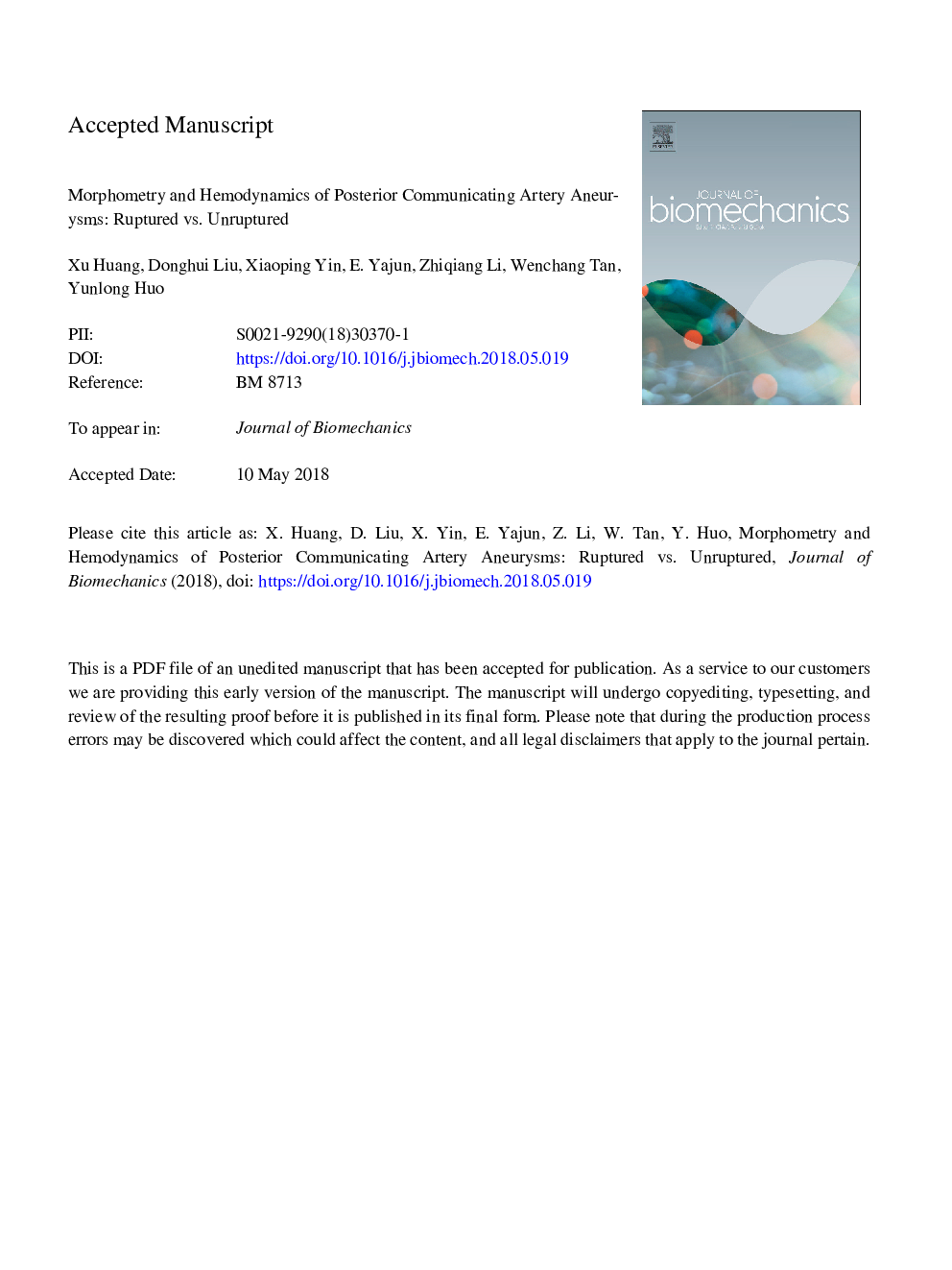| کد مقاله | کد نشریه | سال انتشار | مقاله انگلیسی | نسخه تمام متن |
|---|---|---|---|---|
| 7235713 | 1471088 | 2018 | 24 صفحه PDF | دانلود رایگان |
عنوان انگلیسی مقاله ISI
Morphometry and hemodynamics of posterior communicating artery aneurysms: Ruptured versus unruptured
ترجمه فارسی عنوان
مورفومتری و همودینامیک آنوریسمهای شریانی ارتباطی خلفی: شکستگی در مقابل شکستگی
دانلود مقاله + سفارش ترجمه
دانلود مقاله ISI انگلیسی
رایگان برای ایرانیان
کلمات کلیدی
موضوعات مرتبط
مهندسی و علوم پایه
سایر رشته های مهندسی
مهندسی پزشکی
چکیده انگلیسی
Posterior communicating artery (PCoA) aneurysms frequently rupture in small size (<7â¯mm). The aim of the study is to demonstrate morphometric and hemodynamic analyses in ruptured and unruptured PCoA aneurysms to improve predictive accuracy for rupture. Geometrical models were reconstructed from rotational DSA images of 57 ruptured and 22 unruptured side-wall PCoA aneurysms, which were classified into four two-dimensional (2D) groups by a combination of H/D and H/S ratios (H: dome height, D: dome diameter, and S: semi-axis height). Surface area ratio (SAR) of low time-averaged wall shear stress (TAWSS, â¤4 dynesâ¯cmâ2) and high oscillatory shear index (OSI, â¥0.15) were computed in aneurysms. We hypothesized that a two-step analysis method, i.e., one-dimensionally morphometric and hemodynamic analyses in each 2D group, can enhance accuracy of PCoA aneurysm rupture evaluation. There was the highest incidence of H/Dâ¯>â¯1 and H/Sâ¯â¤â¯2 with the largest surface area and SAR-TAWSS, but the lowest incidence of H/Dâ¯â¤â¯1 and H/Sâ¯>â¯2 with the smallest surface area and SAR-TAWSS in ruptured PCoA aneurysms. PCoA aneurysms of H/Dâ¯>â¯1 and H/Sâ¯â¤â¯2 with surface areaâ¯>â¯70â¯mm2, H/Dâ¯â¤â¯1 and H/Sâ¯>â¯2 with neck diameterâ¯>â¯2.3â¯mm, H/Dâ¯â¤â¯1 and H/Sâ¯â¤â¯2 with aneurysmal height/parent diameter ratioâ¯>â¯1.0, and H/Dâ¯>â¯1 and H/Sâ¯>â¯2 with aneurysmal angleâ¯>â¯115° need special attention for clinical diagnosis and treatment. The study highlighted the importance of the two-step analysis method for clinical evaluation of PCoA aneurysm rupture.
ناشر
Database: Elsevier - ScienceDirect (ساینس دایرکت)
Journal: Journal of Biomechanics - Volume 76, 25 July 2018, Pages 35-44
Journal: Journal of Biomechanics - Volume 76, 25 July 2018, Pages 35-44
نویسندگان
Xu Huang, Donghui Liu, Xiaoping Yin, Yajun E, Zhiqiang Li, Wenchang Tan, Yunlong Huo,
